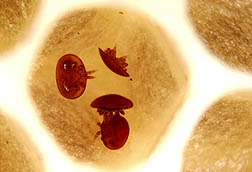Luring Varroa Mites to Their Doom
The Varroa mite, Varroa destructor, is only about one-sixteenth of an inch long. But that hasn’t stopped the eight-legged, blood-sucking parasite from becoming the single worst pest of honey bees since first being detected in Florida in the 1980s.
Any threat to honey bees is a threat to American agriculture. Without them, the yield and quality of many flowering crops would suffer—almonds, apples, blueberries, cantaloupe, cranberries, and zucchini, to name just a few. Indeed, as the chief pollinator of these crops, the honey bee’s contributions are considered a $14 billion asset to our economy—and that’s not even counting the honey and beeswax the insect produces.
So it is with quite a bit of urgency that researchers nationwide are seeking new ways to control Varroa, particularly methods that will diminish reliance on the chemical controls—fluvalinate and coumaphos—now used. At the ARS Chemistry Research Unit in Gainesville, Florida, research leader Peter E.A. Teal is testing a bait-and-kill approach using sticky boards dosed with natural chemical attractants, called “semiochemicals.”
For patenting reasons, Teal won’t reveal what the specific compounds are, other than to say they’re naturally produced by honey bees and highly attractive to Varroa mites.
In nature, Varroa mites rely on the semiochemicals to locate—and then feed on the bloodlike hemolymph of—both adult bees and their brood, weakening or killing them. Severe infestations can decimate an affected hive within several months—and rob the beekeeper of profits from honey or pollinating services. But in this case, the mites encounter a more heady bouquet of honey bee odors that lure them away from their intended hosts and onto the sticky boards, where they starve.
Preliminary tests of the attractant have been promising. “For example, we are able to induce 35 to 50 percent of mites to drop off of bees when we present them with either of the two attractants, and more than 60 percent of free mites are attracted to these chemicals in biological tests,” Teal reports. Moreover, it doesn’t appear that the extra dose of semiochemicals wafting through the hive interferes with the honey bees’ normal behavior or activity to any significant degree, adds Teal, who, along with postdoctoral associate Adrian Duehl and University of Florida collaborator Mark J. Carroll, reported the results this past January at the 2009 North American Beekeeping Conference in Reno, Nevada.
The researchers hope ARS’s patenting of the Varroa attractants will encourage an industrial partner to develop the technology further for use by beekeepers as both a monitoring tool and an alternative to chemical controls.—By Jan Suszkiw, Agricultural Research Service Information Staff.
This research is part of Crop Protection and Quarantine, an ARS national program (#304) described on the World Wide Web at www.nps.ars.usda.gov.
Peter E.A. Teal is in the USDA-ARS Chemistry Research Unit, Center for Medical, Agricultural, and Veterinary Entomology, 1600-1700 S.W. 23rd Dr., Gainesville, FL 32608; phone (352) 374-5730, fax (352) 374-5707.
"Luring Varroa Mites to Their Doom" was published in the July 2009 issue of Agricultural Research magazine.







